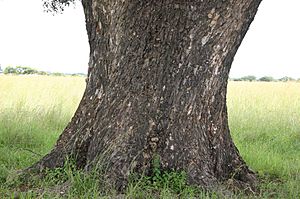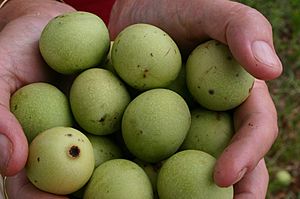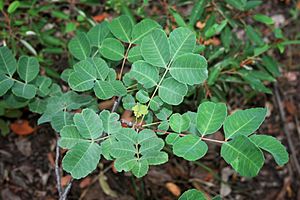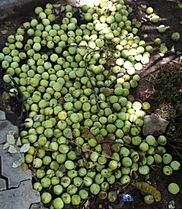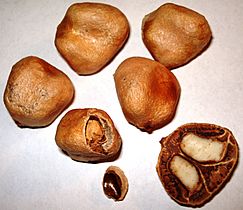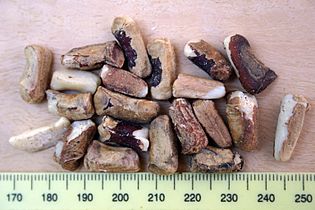Marula facts for kids
Quick facts for kids Marula |
|
|---|---|
 |
|
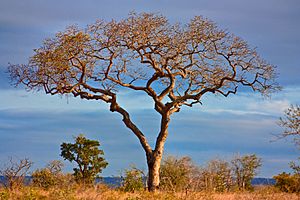 |
|
| S. birrea with and without foliage | |
| Scientific classification | |
| Genus: |
Sclerocarya
|
| Species: |
birrea
|
| Synonyms | |
|
Poupartia birrea (A. Rich.) Aubrév |
|
The Marula tree, also known by its scientific name Sclerocarya birrea, is a medium-sized tree that loses its leaves every year. It grows tasty fruits. The name Sclerocarya comes from ancient Greek words meaning "hard nut," because of the tough stone inside its fruit.
Marula trees are native to many parts of Africa, including Southern Africa, West Africa, East Africa, and Madagascar. You can find them in woodlands and savannas.
Contents
What the Marula Tree Looks Like
The Marula tree has a single trunk and a wide, spreading top. Its bark is grey and has a mottled (spotty) look. These trees can grow up to 18 meters (about 60 feet) tall. They usually grow in lower areas and open woodlands.
People have helped spread Marula trees across Africa. There is also proof that people have grown these trees on farms. Trees grown on farms often have bigger fruits.
Marula Fruit and Seeds
Marula fruits become ripe between December and March. When they are ripe, their skin is light yellow. The inside part of the fruit is white and juicy. The fruits fall to the ground when they are still green and unripe. They then turn yellow and ripen on the ground.
The fruit tastes a bit sour but has a strong, special flavor. Inside the fruit is a hard, nut-sized stone. This stone is very thick. When the stones dry, they open up. They have two (sometimes three) small, round plugs that fall out. This lets you get to the seeds inside.
The seeds have a delicate, nutty taste. Many small animals, especially rodents, love them. These animals know exactly where to gnaw to get to the seeds.
Marula Flowers and Leaves
Marula trees have separate male and female trees. This means a tree is either male or female.
Male trees grow many male flowers on a long stalk. These flowers have red parts and about 20 stamens (the parts that make pollen). Sometimes, a male flower can also have a female part, making it a mix.
Female flowers grow one by one on their own small stalks. They have small, undeveloped stamens.
The leaves of the Marula tree grow in an alternating pattern. They are made up of several smaller leaflets. These leaflets can be round or oval shaped.
Naming the Marula Tree
The Marula tree, Sclerocarya birrea, has three main types, called subspecies. These types are a bit different in their leaf shapes and sizes.
- One type, subsp. birrea, is found in northern Africa.
- Another type, subsp. caffra, grows in southern Africa.
- The third type, subsp. multifoliolata, is only found in Tanzania.
The name Sclerocarya comes from two old Greek words: 'skleros' which means 'hard', and 'karyon' which means 'nut'. This name points to the hard pit inside the fruit. The second part of the name, 'birrea', comes from 'birr'. This is a common name for this tree in Senegal.
The Marula tree belongs to the same plant family as the mango, cashew, pistachio, and sumac. This family is called Anacardiaceae.
People also call the Marula tree by other names, like jelly plum, cider tree, and maroola nut. In South Africa, it's often called maroela.
How People Use Marula
Traditional Uses
For a long time, people in Africa have used Marula fruit as food. It is very important for many communities.
- Drinks: People mix the fruit juice and pulp with water. They let it sit for a few days to ferment. This makes a traditional alcoholic drink called marula beer.
- Oil: Marula oil is taken from the seeds. People use it on their skin to keep it moist. It is also used as a cooking oil, especially by the San people in Southern Africa.
- Protection: In South Africa, the Marula tree is a protected tree.
Commercial Uses
Today, Marula fruit is also used in businesses.
- Income: People in rural areas collect the fruit from wild trees. They sell the fruit, which helps them earn money. This is especially important for women in these communities.
- Products: The collected fruit goes to factories. There, the fruit pulp, seeds, and oil are taken out. These parts are then used to make different products.
- Liqueur and Puree: The fruit is used to make a creamy drink called Amarula. It is also sold as a frozen puree that can be used in juice mixes.
- Cosmetics: Marula oil is a popular ingredient in beauty products like lotions and creams.
Uses by Animals
Many animals in Southern Africa eat Marula fruit.
- Elephants: Elephants, giraffes, and rhinoceroses all eat parts of the Marula tree. Elephants especially love Marula trees. They eat the bark, branches, and fruits. This can sometimes stop the trees from spreading too much. When you see a Marula tree with damaged bark, it often means an elephant has been eating it. Elephants also help spread Marula seeds when they poop them out.
- Fermented Fruit: You might have heard stories or seen videos of animals acting tipsy after eating Marula fruit. While the fruit does ferment on the ground, animals would need to eat a very large amount of it to feel any effects. Most animals prefer to eat the fresh, ripe fruit.
- Fruit Flies: Scientists think that the Marula fruit might have been the favorite food for a type of fruit fly called Drosophila melanogaster a long time ago. These flies were attracted to a special smell in the Marula fruit.
Gallery
See also
 In Spanish: Sclerocarya birrea para niños
In Spanish: Sclerocarya birrea para niños


